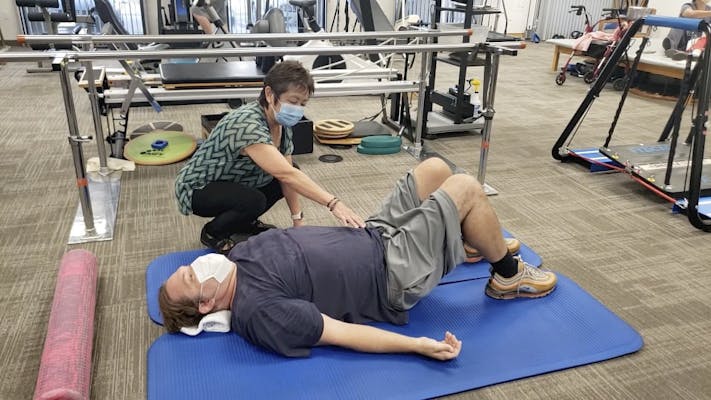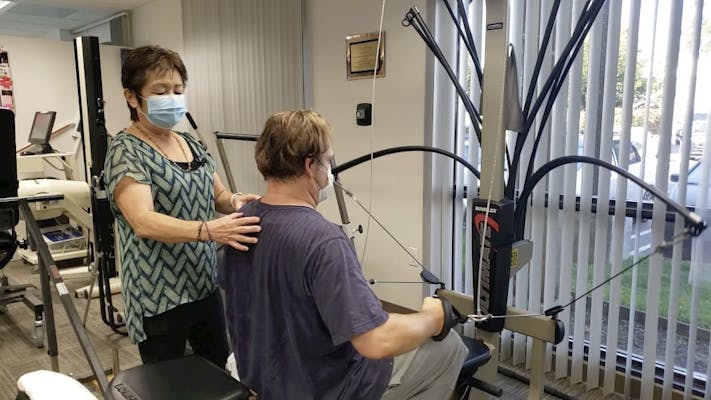Exercising with osteoporosis: Stay active the safe way
The low bone density and osteoporosis program is spearheaded by Sharon Kato, PT, who was trained by highly-regarded physical therapist Sara Meeks. With more than 15 years of experience in this specialized field, Sharon follows a 12-point approach that is an evidence-based, safe, and therapeutic movement program customizable to all levels of care and age groups. This approach is also useful in the care of patients with back conditions such as spinal stenosis, spondylolisthesis, and degenerative disc disease among others.
How Exercise Helps with OsteoporosisIf you have osteoporosis, you might mistakenly think exercise will lead to fracture. In fact, though, using your muscles helps protect your bones.
Osteoporosis is a major cause of disability in older women. A bone-weakening disorder, osteoporosis often results in fractures in the hip and spine — which can severely impair your mobility and independence.
How can you reduce your risk of these life-altering injuries? Exercise can help. Certain types of exercise may strengthen muscles and bones, while other types of exercises are designed to improve your balance — which can help prevent falls.
Benefits of exercise
Women who have been physically active throughout their lives generally have stronger bones than do women who have led more sedentary lives. But it's never too late to start exercising. For postmenopausal women, regular physical activity can:
- Increase your muscle strength
- Improve your balance
- Make you better able to carry out daily tasks and activities
- Maintain or improve your posture
- Relieve or decrease pain
- Improve your sense of well-being
- Exercising if you have osteoporosis means finding the safest, most enjoyable activities for you given your overall health and amount of bone loss. There's no one-size-fits-all prescription.
Before you start
Consult your doctor before starting any exercise program for osteoporosis. You may need some tests first, including:
- Bone density measurement
- Fitness assessment
- In the meantime, think about what kind of activities you enjoy most. If you choose an exercise you enjoy, you're more likely to stick with it over time.
Choosing the right form of exercise
These types of activities are often recommended for people with osteoporosis:- Strength training exercises, especially those for the upper back
- Weight-bearing aerobic activities
- Flexibility exercises
- Stability and balance exercises
- Because of the varying degrees of osteoporosis and the risk of fracture, certain exercises may be discouraged. Ask your doctor or physical therapist whether you're at risk of osteoporosis-related problems, and find out what exercises are appropriate for you.
Strength training
Strength training includes the use of free weights, weight machines, resistance bands or water exercises to strengthen the muscles and bones in your arms and upper spine. Strength training can also work directly on your bones to slow mineral loss. Osteoporosis can cause compression fractures in your spinal column. These fractures often lead to a stooped posture. Exercises that gently stretch and extend your upper back, strengthen the muscles between your shoulder blades, and improve your posture can all help to reduce harmful stress on your bones and maintain bone density.
Weight-bearing aerobic activities
Weight-bearing aerobic activities involve doing aerobic exercise on your feet, with your bones supporting your weight. Examples include walking, dancing, low-impact aerobics, elliptical training machines, stair climbing and gardening. These types of exercise work directly on the bones in your legs, hips and lower spine to slow mineral loss. They can also provide cardiovascular benefits, which boost heart and circulatory system health. Swimming and water aerobics have many benefits, but they don't have the impact your bones need to slow mineral loss. However, these activities can be useful in cases of extreme osteoporosis, during rehabilitation following a fracture or for increasing aerobic capacity.
Flexibility exercises
Being able to move your joints through their full range of motion helps you maintain good balance and prevent muscle injury. Stretches are best performed after your muscles are warmed up — at the end of your exercise session, for example. They should be done gently and slowly, without bouncing. Avoid stretches that flex your spine or cause you to bend at the waist. Ask your doctor which stretching exercises would be best for you.
Stability and balance exercises
Fall prevention is important for people who have osteoporosis. Stability and balance exercises help your muscles work together in a way that helps keep you more stable and less likely to fall. Simple exercises such as standing on one leg or movement-based exercises such as tai chi can improve your stability and balance.
Movements to avoid
If you have osteoporosis, don't do the following types of exercises:High-impact exercises. Activities such as jumping, running or jogging can lead to fractures in weakened bones. Avoid jerky, rapid movements in general. Choose exercises with slow, controlled movements. Exercises in which you bend forward and twist your waist, such as touching your toes or doing situps, can increase your risk of compression fractures in your spine. Other activities that may require you to bend or twist forcefully at the waist are golf, tennis, bowling and some yoga poses. If you're not sure how healthy your bones are, talk to your doctor. Don't let fear of fractures keep you from having fun and being active.


